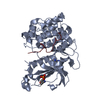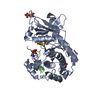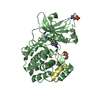Entry Database : PDB / ID : 4dc2Title Structure of PKC in Complex with a Substrate Peptide from Par-3 Partitioning defective 3 homolog Protein kinase C iota type Keywords / / / / / / Function / homology Function Domain/homology Component
/ / / / / / / / / / / / / / / / / / / / / / / / / / / / / / / / / / / / / / / / / / / / / / / / / / / / / / / / / / / / / / / / / / / / / / / / / / / / / / / / / / / / / / / / / / / / / / / / / / / / / / / / / / / / / / / / / / / / / / / / / / / / / / / / / / / / / / / / / / / / / / / / / / Biological species Mus musculus (house mouse)Rattus norvegicus (Norway rat)Method / / / Resolution : 2.4 Å Authors Shang, Y. / Wang, C. / Yu, J. / Zhang, M. Journal : Structure / Year : 2012Title : Substrate recognition mechanism of atypical protein kinase Cs revealed by the structure of PKC iota in complex with a substrate peptide from Par-3Authors : Wang, C. / Shang, Y. / Yu, J. / Zhang, M. History Deposition Jan 17, 2012 Deposition site / Processing site Revision 1.0 Jul 11, 2012 Provider / Type Revision 1.1 Nov 20, 2024 Group Data collection / Database references ... Data collection / Database references / Derived calculations / Structure summary Category chem_comp_atom / chem_comp_bond ... chem_comp_atom / chem_comp_bond / database_2 / pdbx_entry_details / pdbx_modification_feature / struct_conn / struct_ref_seq_dif / struct_site Item _database_2.pdbx_DOI / _database_2.pdbx_database_accession ... _database_2.pdbx_DOI / _database_2.pdbx_database_accession / _struct_conn.pdbx_leaving_atom_flag / _struct_ref_seq_dif.details / _struct_site.pdbx_auth_asym_id / _struct_site.pdbx_auth_comp_id / _struct_site.pdbx_auth_seq_id
Show all Show less
 Open data
Open data Basic information
Basic information Components
Components Keywords
Keywords Function and homology information
Function and homology information

 X-RAY DIFFRACTION /
X-RAY DIFFRACTION /  SYNCHROTRON /
SYNCHROTRON /  MOLECULAR REPLACEMENT / Resolution: 2.4 Å
MOLECULAR REPLACEMENT / Resolution: 2.4 Å  Authors
Authors Citation
Citation Journal: Structure / Year: 2012
Journal: Structure / Year: 2012 Structure visualization
Structure visualization Molmil
Molmil Jmol/JSmol
Jmol/JSmol Downloads & links
Downloads & links Download
Download 4dc2.cif.gz
4dc2.cif.gz PDBx/mmCIF format
PDBx/mmCIF format pdb4dc2.ent.gz
pdb4dc2.ent.gz PDB format
PDB format 4dc2.json.gz
4dc2.json.gz PDBx/mmJSON format
PDBx/mmJSON format Other downloads
Other downloads 4dc2_validation.pdf.gz
4dc2_validation.pdf.gz wwPDB validaton report
wwPDB validaton report 4dc2_full_validation.pdf.gz
4dc2_full_validation.pdf.gz 4dc2_validation.xml.gz
4dc2_validation.xml.gz 4dc2_validation.cif.gz
4dc2_validation.cif.gz https://data.pdbj.org/pub/pdb/validation_reports/dc/4dc2
https://data.pdbj.org/pub/pdb/validation_reports/dc/4dc2 ftp://data.pdbj.org/pub/pdb/validation_reports/dc/4dc2
ftp://data.pdbj.org/pub/pdb/validation_reports/dc/4dc2 Links
Links Assembly
Assembly
 Components
Components


 X-RAY DIFFRACTION / Number of used crystals: 1
X-RAY DIFFRACTION / Number of used crystals: 1  Sample preparation
Sample preparation SYNCHROTRON / Site:
SYNCHROTRON / Site:  SSRF
SSRF  / Beamline: BL17U
/ Beamline: BL17U Processing
Processing MOLECULAR REPLACEMENT / Resolution: 2.4→21.179 Å / Occupancy max: 1 / Occupancy min: 0 / FOM work R set: 0.8302 / SU ML: 0.33 / σ(F): 0 / Phase error: 24.25 / Stereochemistry target values: ML
MOLECULAR REPLACEMENT / Resolution: 2.4→21.179 Å / Occupancy max: 1 / Occupancy min: 0 / FOM work R set: 0.8302 / SU ML: 0.33 / σ(F): 0 / Phase error: 24.25 / Stereochemistry target values: ML Movie
Movie Controller
Controller













 PDBj
PDBj













